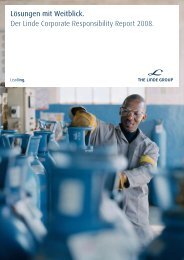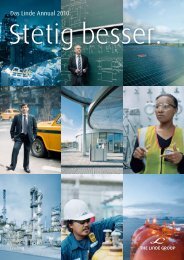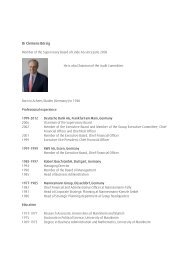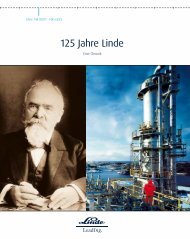The complete history of the development of The - The Linde Group
The complete history of the development of The - The Linde Group
The complete history of the development of The - The Linde Group
Create successful ePaper yourself
Turn your PDF publications into a flip-book with our unique Google optimized e-Paper software.
1956 1957<br />
First telephone cable between Europe<br />
and <strong>the</strong> US goes into operation.<br />
Hydrostatics – it started with <strong>the</strong> Hydrocar<br />
Seeking new products to <strong>of</strong>fset <strong>the</strong> stagnating<br />
demand for tractors, <strong>the</strong> Güldner<br />
Motoren-Gesellschaft took over <strong>the</strong><br />
hydrostatics operations <strong>of</strong> <strong>the</strong> Saalmann<br />
company in <strong>the</strong> mid-1950s, including all<br />
employees working in that area.<br />
In a hydrostatic drive, a rotating cylinder<br />
drum driven by a combustion motor<br />
pumps oil into a driving gear at high<br />
pressure (420 bar) by means <strong>of</strong> pistons.<br />
This driving gear in turn is rotated by<br />
means <strong>of</strong> its pistons. <strong>The</strong> flow and, thus,<br />
<strong>the</strong> rate <strong>of</strong> rotation is controlled by a<br />
swash plate whose tilt angle determines<br />
A Güldner Hydrocar tows an air force plane. <strong>The</strong>se vehicles were built from<br />
1958 to 1965 in Aschaffenburg.<br />
<strong>The</strong> “Hubtrac” was <strong>the</strong> first <strong>Linde</strong> forklift truck; it was built from 1959 to 1969.<br />
52<br />
<strong>the</strong> piston stroke (see also page 56).<br />
Transmission gears in <strong>the</strong> driving gear<br />
reduce <strong>the</strong> rate <strong>of</strong> rotation from 2000 to<br />
200 rpm and transmit this to <strong>the</strong> wheels<br />
<strong>of</strong> a vehicle such as a forklift.<br />
<strong>The</strong> change in <strong>the</strong> rotation speed is<br />
smooth. A significant advantage <strong>of</strong> <strong>the</strong><br />
hydrostatic drive is that both acceleration<br />
and braking are effectively achieved by<br />
depressing <strong>the</strong> pedal to adjust <strong>the</strong> swash<br />
plate <strong>of</strong> <strong>the</strong> vehicle – and without any<br />
wear. Ano<strong>the</strong>r point in favor <strong>of</strong> <strong>the</strong> hydrostatic<br />
drive is that <strong>the</strong> vehicle runs<br />
smoothly at <strong>the</strong> same speed once it has<br />
Sputnik I, <strong>the</strong> first artificial satellite,<br />
orbits <strong>the</strong> Earth.<br />
N o 1461<br />
Vehicle whose movement is<br />
controlled by pedals (Hydrocar).<br />
been set – no matter <strong>the</strong> resistance, such<br />
as when it goes over a threshold.<br />
Finally, <strong>the</strong> hydrostatically driven vehicle<br />
can be operated away from its energy<br />
source; it can be connected over a distance<br />
using cables and hoses.<br />
<strong>Linde</strong> tested this hydrostatic drive in<br />
<strong>the</strong> “Hydrocar” starting in 1958, which<br />
was primarily used for internal transport.<br />
After extensive testing, <strong>the</strong> Hydrocar<br />
made up <strong>the</strong> core around which today’s<br />
<strong>Linde</strong> Material Handling Division was<br />
built. From <strong>the</strong> beginning, <strong>the</strong> first hydrostatically<br />
driven forklift had a smooth<br />
ride, simple, precise handling, low wear<br />
and high safety.<br />
In <strong>the</strong> course <strong>of</strong> ongoing <strong>development</strong>,<br />
<strong>Linde</strong> integrated <strong>the</strong> hydrostatic<br />
drive, hydraulic pump, hydraulic motor<br />
and gearbox into one compact axle. <strong>The</strong><br />
latest generation <strong>of</strong>fers a higher power<br />
density (greater pivoting angle) and can<br />
do without <strong>the</strong> mechanical gear transmission<br />
stage since <strong>the</strong> wheels are driven<br />
directly by <strong>the</strong> “slow running” hydraulic<br />
motor.<br />
<strong>The</strong> “intelligent” electronics provide<br />
excellent driving behavior and make optimal<br />
use <strong>of</strong> <strong>the</strong> power <strong>of</strong> <strong>the</strong> diesel engine,<br />
thus minimizing fuel consumption.<br />
<strong>Linde</strong> Series 313 forklifts were produced from 1967 to 1977.<br />
<strong>Linde</strong> hydrostatics supplies not only<br />
<strong>the</strong> forklift customers in its own plant but<br />
also a number <strong>of</strong> outside customers, such<br />
as manufacturers <strong>of</strong> construction machinery,<br />
harvesters, street-cleaning and refuse<br />
vehicles. One <strong>of</strong> its specialties is <strong>the</strong><br />
drive for baggers: One hydraulic pump<br />
can control several “consumers” (such as<br />
a drive motor and shovel) at <strong>the</strong> same<br />
time without affecting <strong>the</strong>ir performance.<br />
Here too electronics developed at <strong>Linde</strong><br />
ensure sensitive control and optimal use<br />
<strong>of</strong> <strong>the</strong> power.<br />
<strong>The</strong> hydrostatics shop at <strong>the</strong> Aschaffenburg<br />
plant now makes some 120,000<br />
units per year, about half <strong>of</strong> which are for<br />
external customers.


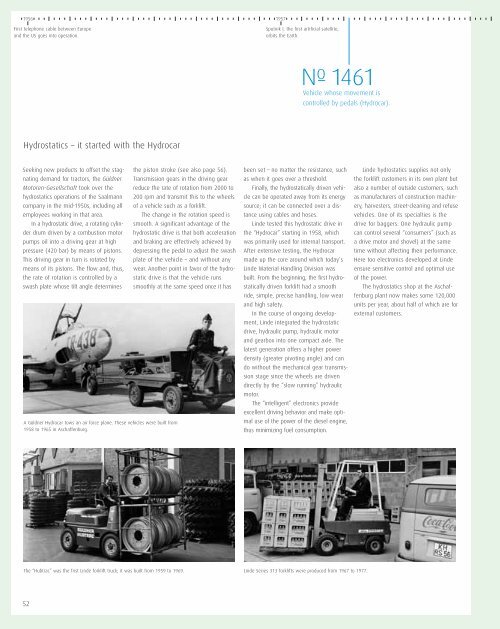

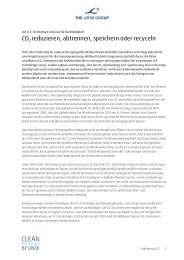

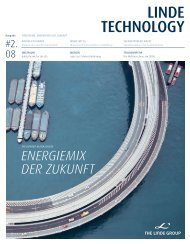
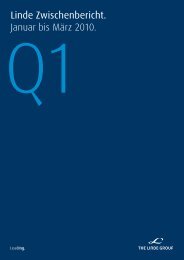
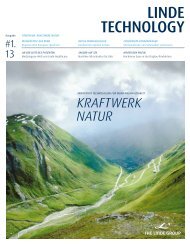

![[41] Anteilsbesitzliste des Linde Konzerns und ... - The Linde Group](https://img.yumpu.com/8356102/1/184x260/41-anteilsbesitzliste-des-linde-konzerns-und-the-linde-group.jpg?quality=85)
![[41] Anteilsbesitzliste des Linde Konzerns und ... - The Linde Group](https://img.yumpu.com/8356076/1/184x260/41-anteilsbesitzliste-des-linde-konzerns-und-the-linde-group.jpg?quality=85)
